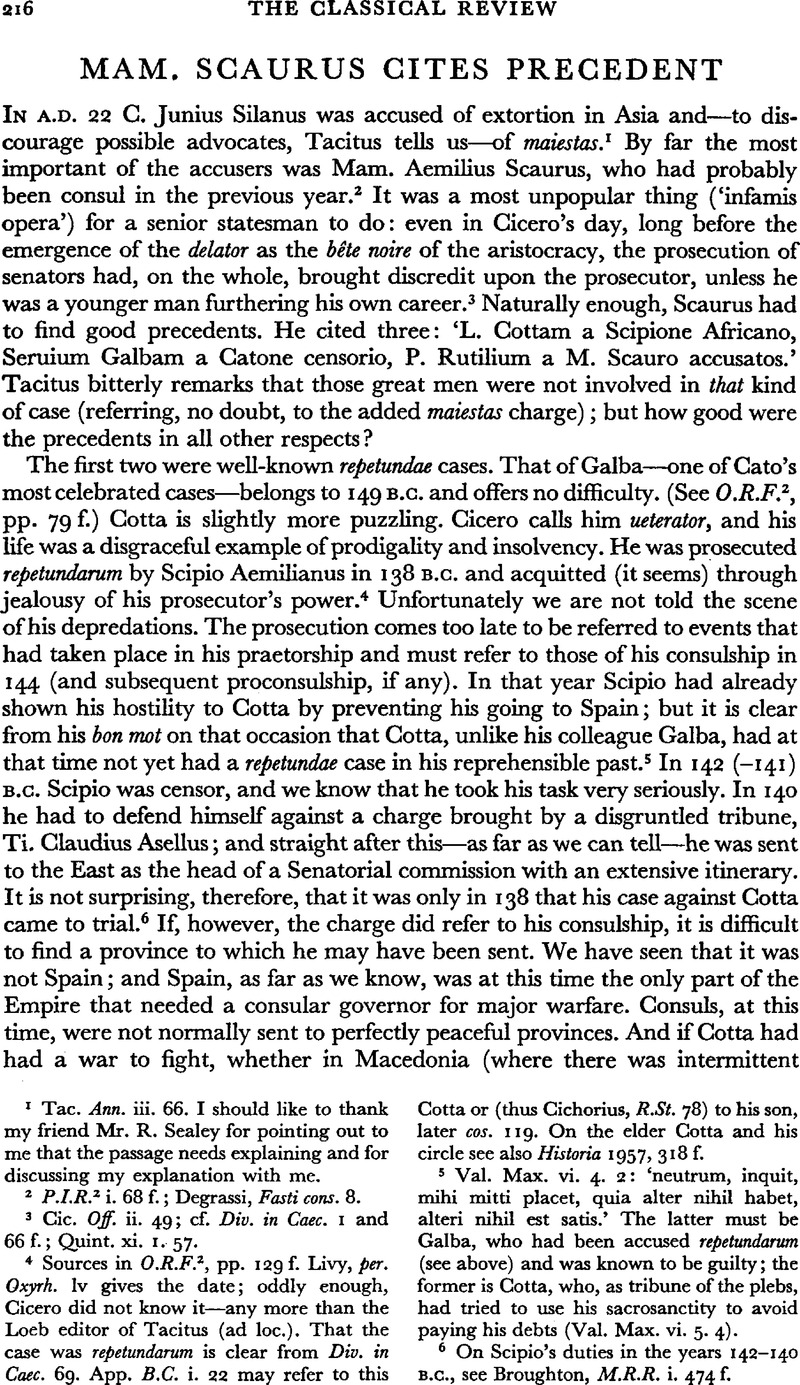Article contents
Mam. Scaurus Cites Precedent
Published online by Cambridge University Press: 13 February 2009
Abstract

Information
- Type
- Review Article
- Information
- Copyright
- Copyright © The Classical Association 1958
References
page 216 note 1 Tac. Ann. iii. 66. I should like to thank my friend Mr. R. Sealey for pointing out me that the passage needs explaining and for discussing my explanation with me.
page 216 note 2 P.I.R.2 i. 68 f.; Degrassi, Fasti cons. 8.
page 216 note 3 Cic. Off. ii. 49; cf. Div. in Caec. 1 66 f.; Quint, xi. 1. 57.
page 216 note 4 Sources in O.R.F.2, pp. 129 f. Livy, per Oxyrh. Iv gives the date; oddly enough, Cicero did not know it—any more than the Loeb editor of Tacitus (ad loc). That the case was repetundarum is clear from Div.in.Caec. 69. App. B.C. i. 32 may refer to this Cotta or (thus Cichorius, R.St. 78) to his son, later cos. 119. On the elder Cotta and his circle see also Historia 1957, 318 f.
page 216 note 5 Val. Max. vi. 4. 2: ‘neutrum, inquit, mihi mitti placet, quia alter nihil habet, alteri nihil est satis.’ The latter must be Galba, who had been accused repetundarum (see above) and was known to be guilty; the former is Cotta, who, as tribune of the plebs, had tried to use his sacrosanctity to avoid paying his debts (Val. Max. vi. 5. 4).
page 216 note 6 On Scipio's duties in the years 142–40 B.C., see Broughton, , M.R.R. i. 474 f.Google Scholar
page 217 note 1 Suet. Jul. 19. 2. This, incidentally, is often misunderstood. It is clearly a traditional formula and means the suppression of brigandage in Italy, such as occurred even in Gracthe second century B.C. For a proconsul doing odd jobs in Gaul, see the inscription of Sex. Atilius Saranus, the consul of 136 (I.L.S. 5945). But we do not know what his prouincia had been—Italia is as likely as Gaul.
page 217 note 2 App. B.C. i. 19. For what Roman magistrates could do in Italy, cf. C. Gracchus ap. Gell. x. 3.2 f.
page 217 note 3 On Scaurus' family and his struggle to establish himself, see Bloch, , M. Aem. Scaurus, pp. 3 f.Google Scholar
page 218 note 1 Broughton, (M.R.R. ii. 8–9)Google Scholar lists over thirty references to the case.
page 218 note 2 On all this see Athenaeum, 1956, pp.104 f.Google Scholar, especially 117 f.
page 218 note 3 On his state of health see Asc, p. 23 Cl. His delatio of Q.Caepio in 92 was a tactical manœuvre, not meant to result in a real trial.
page 218 note 4 See n. I (above). The argument from silence here surely seems justified. Cf., e.g., Cic. Br. 110 f.: a parallel treatment of Scaurus and Rutilius, describing their clash in 116, then going on to discuss Rutilius' showing at his trial in 92 without a word of Scaurus.
page 219 note 1 Posidonius ap. Athcn. iv. 66 (168 D): this cannot really mean anything but that Apicius was Rutilius' prosecutor. That the princeps senatus acted as subscriptor to the Roman Knight is inconceivable.
page 219 note 2 Asa, loc. cit.;—cf. Athenaeum, 1956, pp. 117 f.Google Scholar
page 219 note 3 For examples of inaccuracy and misleading formulation, see Ann. iii. 26 f. (a ‘history’ of legislation in Rome); xi. 22 (a history of the quaestorship); xii. 60 (the judiciary laws); and, on a minor biographical matter, xiii. 6 (Pompey's age).
page 219 note 4 Cf. Ann. ii. 88. Tacitus' methods are treated in all the standard editions.
page 219 note 5 Apart from Tacitus (loc. cit., and vi. 29: ‘uita probrosus’), see especially Sen. Ben. iv. 31.
page 219 note 6 Tert. De Pallio 5, fin., must refer to him.
page 219 note 7 See Seneca's long discussion of him in Cont. x, praef. 2–3.
- 2
- Cited by

